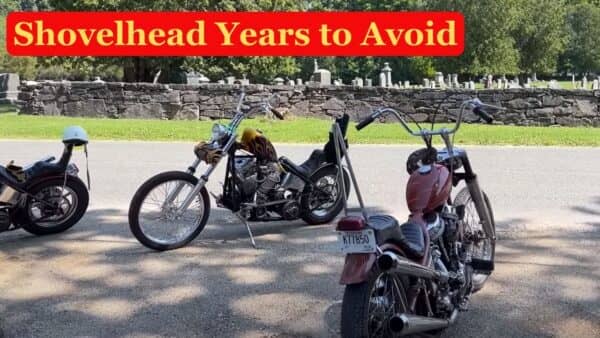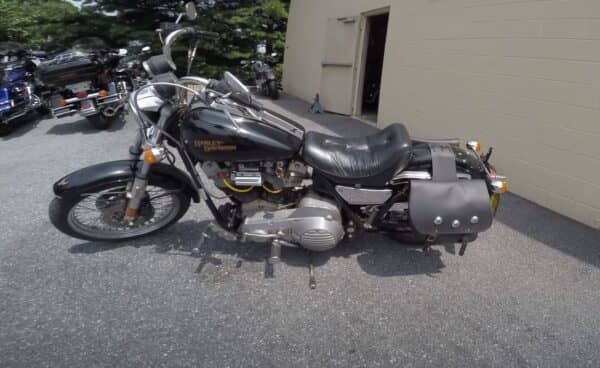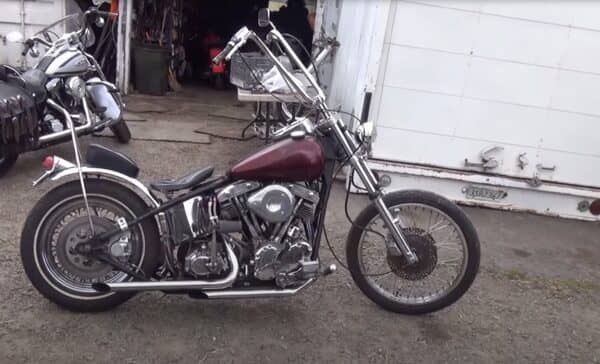
If you are going to buy a Shovelhead for yourself, then this article is just for you. Because in this article, I have explained Shovelhead’s years to avoid.
Before deciding on a model for Shovelhead, you should have to consider the problems of all models so it will help you choose the best for you.
I have also listed the Shovelhead years which are best and you can buy these years’ models.
Let’s dive into:
Which years should you avoid Shovelhead?
Shovelhead is considered the fanciest motorbike globally due to its functions.
It has the most powerful engine, making it compatible with long rides; with its powerful engine, you can do offroading easily.
But if you’re looking for the old model of the Shovelhead to buy, then you must avoid a few of the model years of the Shovelhead.
Due to these years, shovelheads have problems with their parts, like more fuel consumption and faulty engines.
If you’re considering the old model of Shovelhead, then you must consider the engine health and all parts of the bike to ensure it’s not faulty or damaged.
Related: Harley Fat Boy Years You Should Not Buy
1983 Shovelhead

The Harley-Davidson Shovelhead, known for its shovel-shaped rocker covers, was a beloved series in the motorcycling community.
But the Shovelhead 1983 has some issues, some mentioned below.
The Electric Issue
Electric problems have always been a motorcyclist’s worst nightmare, and the 1983 Shovelhead was no exception.
Owners of this model have reported persistent electrical malfunctions, ranging from intermittent lighting failures to battery-draining issues.
The wiring system of the 1983 variant seemed to be more susceptible to wear and tear, leading to frequent short circuits.
The corroded connectors and poor grounding often contributed to its erratic electrical behavior. It wasn’t just an inconvenience but posed significant safety risks for riders.
The Faulty Starter
Starting troubles can turn any pleasant motorbike experience into a daunting one.
The 1983 Shovelhead’s starter was notoriously unreliable. Many riders often found themselves stranded due to a non-responsive starter.
The root of the problem was two-fold. First, the starter’s components were not up to the mark regarding quality.
Wear and tear happened at an accelerated pace, leading to starter failures. Secondly, the design itself was flawed.
It lacked the robustness required for a motorcycle with the Shovelhead’s caliper. Given customers’ premium for a Harley-Davidson, such issues were, understandably, a source of significant frustration.
Oiling Problems
A smoothly functioning engine relies heavily on an effective oiling system. Unfortunately, the 1983 Shovelhead faced its fair share of oiling troubles.
There were oil leaks, especially around the base of the cylinders and the rocker boxes.
But it wasn’t just the leaks; some riders reported inefficient oil circulation, which could lead to overheating and potential engine damage.
The oil pumps often needed replacements and even might not be entirely resolved.
1978 Shovelhead

Oil Spray Out:
The oil spray was one of the most reported problems with the 1978 Shovelhead. Many owners found that the engine spewed oil, especially after long rides.
This made a mess and posed potential safety hazards, as excess oil on the road can lead to slippery conditions, increasing the risk of accidents.
Oil Refilling problem
Another oil-related concern was the refilling problem. Filling the oil tank of a 1978 Shovelhead was often a game of patience.
The design led to an issue where the oil wouldn’t settle quickly, causing an overflow if not filled slowly and cautiously.
This design flaw made oil changes a longer, more tedious process than needed.
Clutch Complications
The clutch issue was another noticeable problem. Many riders found that the clutch didn’t disengage smoothly, leading to rough shifts and sometimes even stalling.
Over time, this could result in wear and tear on the transmission, demanding costly repairs and replacements.
Points and Firing problems
The 1978 Shovelhead also suffered from points and firing issues. Many users reported inconsistent firing patterns, causing the engine to misfire or not start altogether.
These problems were frustrating and led to decreased engine efficiency and performance.
A motorcycle’s ignition is its heartbeat, and inconsistencies can lead to problems throughout the vehicle.
1967 Shovelhead

Clutch Disengagement
One of the most notable problems with the 1967 Shovelhead was its clutch disengagement. For those unfamiliar, the clutch disengagement system allows the rider to transition between gears smoothly.
In the case of the 1967 model, riders often reported that the clutch didn’t disengage properly. This made gear transitions clunky and jarring and posed potential risks while riding.
Such a malfunction could lead to unexpected jerks, throwing the rider off balance, especially at high speeds or on rugged terrains.
Shifting Problem
Tied closely with the clutch disengagement issue was the shifting problem. A motorcycle’s ability to shift gears effortlessly is crucial for a smooth riding experience.
Riders of the 1967 Shovelhead reported difficulties when trying to shift gears. Often, they would find themselves stuck in one gear, making it challenging to adapt to changing road conditions or speeds.
A non-responsive gear system can also be dangerous, as it diminishes the rider’s control over the motorcycle.
Worse, it could lead to accidents if riders couldn’t downshift or upshift when needed.
Which years of Shovelhead should you buy?
These are the best years of Shovelhead that you should buy.
1966 Shovelhead

The 1966 Shovelhead brought about an updated top-end design with increased power and a look defining a generation of motorcycles.
For those who appreciate the history and origins of iconic designs, the 1966 model holds a special place.
It’s often sought after by collectors and purists who want the very first iteration of this legendary bike.
1984 Shovelhead

On the other end of the spectrum, we have 1984 Shovelhead, the final year of its production.
By this time, Harley-Davidson had almost two decades to refine the Shovelhead design, making it more reliable and addressing many of the issues from earlier years.
If you’re looking for a blend of vintage aesthetics and improved functionality, the 1984 model is a top contender. Plus, owning any iconic series last year has its unique charm.
1970 Shovelhead
The 1970 Shovelhead stands out for several reasons. By this year, many of the initial kinks and growing pains from the earlier models were sorted out.
It also sits comfortably in the middle of the Shovelhead era, representing a balance of old-school charm and refined engineering.
1981-1982 Shovelhead
These years saw significant updates to the Shovelhead’s design. With enhancements in the frame and other components, the bikes from this period offer a smoother ride compared to some of their predecessors.
If you’re seeking a more modern riding experience while still basking in the vintage of the Shovelhead, the 1981-1982 models offer a compelling choice.
1968-1969 Shovelhead
These were pivotal years for the Shovelhead. With the design still in its infancy, the 1968-1969 models captured the raw essence of what the Shovelhead represented.
They might not have the refinements of the later models, but they have a rugged charm that’s hard to resist.
These are for the enthusiasts who love a motorcycle that’s rough around the edges but filled with character.
FAQ
What problems did the Shovelhead have?
The Harley-Davidson Shovelhead, produced from 1966-1984, faced various problems, including oil leaks, weak valve guides leading to premature wear, overheating due to poor oil circulation, and electrical issues.
Over time Shovelhead’s improved design addressed some concerns, but early models, in particular, were noted for their maintenance needs.
Can a Shovelhead be reliable?
Yes, a Shovelhead can be reliable when properly maintained and updated. Many enthusiasts invest in modern upgrades, regular maintenance, and necessary repairs, which can significantly improve the bike’s performance and reliability.
Like all vintage motorcycles, the key to a reliable Shovelhead is due to consistent care and understanding of its inherent quirks and needs.
What year did they stop making shovelheads?
Harley-Davidson stopped producing the Shovelhead engine in 1984. It was then replaced by the Evolution engine in their motorcycle lineup.
Wrapping Up
I hope this article helps you find out the years of Shovelhead you should avoid buying.
Due to the poor oil and oil filling issues, oil leaked problems, and various other matters.
So that’s why I mentioned some of the year’s models of Shvehead you should consider if you’re planning to buy the Shovelhead bike.
If you’re still confused, reading the Harley user manual for complete guidance would be best.
You may also love to read this:
Harley Twin Cam Years to Avoid

Ahtsham Younas is a passionate blogger and content writer. He loves to ride motorcycles and learn the mechanical process behind the motorcycles.
He has been writing articles in the motorcycle industry since 2019 and has learned many things about motorbike niches.


